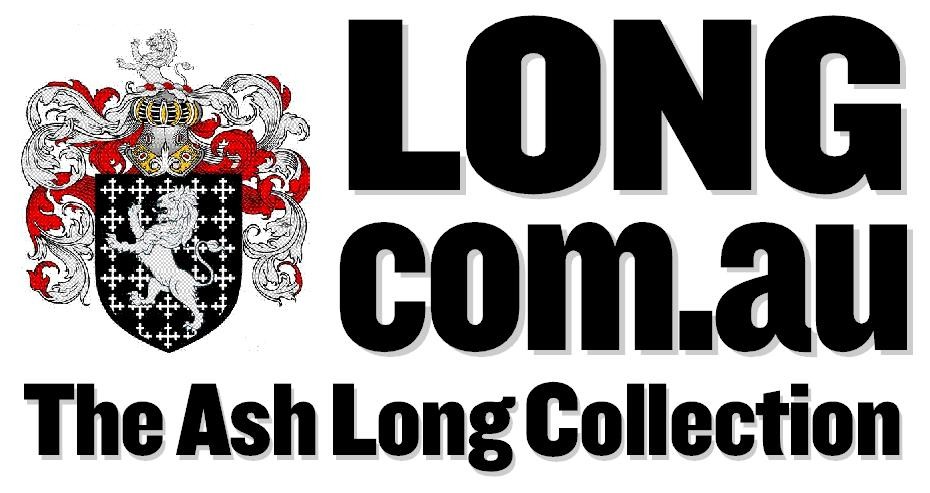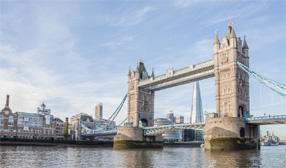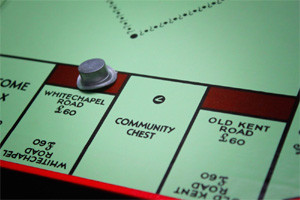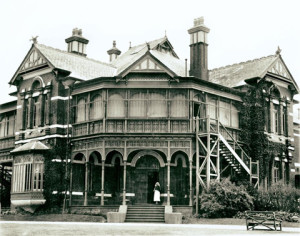Joseph Lawrence: 1869-1954
Friday, April 16, 1869
Joseph (Joe) Lawrence was the father of my maternal grandfather, Albert (Bert) Fletcher Lawrence.
My late aunt, Joy Wood, penned this story in 1992, about Joseph Lawrence:
Joseph (Joe) was my Grandfather. My memories of him are of a well-built man, semi-bald, but with pale gold-coloured hair and moustache. He was very much the gentleman, always well dressed, dominant, autocratic and the Master. Some people would have described him as red-haired and “peppery”. He also smelt of cigars. He always wore a hat.
He was the fifth son of a family of six boys and two girls. As a boy he had left school at the age of 12 years, which was usual in those times. His first job was on a milk cart, delivering milk.
Whilst on this, he broke his leg, and according to my Aunt, a famous specialist set it and a great deal of fuss was made over what was a good job.
He was born on April 16, 1869, at 12 Northampton Terrace, St James Road, Bermondsey, in the sub-district of St James, and the Registrar’s District of St Olave, Southwark, England.
His parents were William Goerge and Elizabeth (nee Lowe) Lawrence.
Bermondsey, where he was born, is on the east side of London, across the Thames River by the Tower Bridge, almost Cockney territory. All the tanneries had been situated here for generatioons as the tanneries were able to use the water from the Neckinger River and were close to the shipping docks where in those days leather was used in great quantities in the building of ships, and for shipping overseas.
Also the smell of the tanneries would have to be contained in one area if possible.
Joseph’s father died at 48 Barkworth Road, Rotherhithe, New Road, Bermondsey, on May 17, 185, age 49 years. My Aunts said he had TB (tuberculosis). On the death certificate, it states Phthisis, one year. His occupation was a Leather Finisher.
Joe would have then been 16 years of age. His mother Elizabeth looked, in her photos and in stories handed down in the family, to have been a rather big woman with a strong character and she lived to a good age. As a boy, Joseph used to swim in the Thames River, and apparently won prizes for swimming. He also used to be an amateur boxer and I believe he sometimes fought bare-fisted. I surmise that a well-built, red-haired aggressive type of young boy would come in for a lot of fighting, especially living in that part of London.
It seems that he worked with other members of his family in the leather trade. His father was a Leather Finisher and the roots of the family seem to be in the leather industry. It seems that leather may have been the Lawrence family’s trade for many years.
Joseph Lawrence married Sarah Jane (nee Fletcher) on March 1, 1890, at St Phillip’s Church in the Parish of Camberwell, London. He was noted as a Leather Dresser and is listed on the Certificate as being 21 years of age. His younger sister Ada married Sarah’s younger brother Harry the following year in the same Church, so the two families must have been friendly.
Both Sarah and Harry Fletcher were children of John and Ann (nee Smith) Fletcher, also in the tanning industry, and whose family were tanners in the Cockermouth area of Cumberland (or Cumbria)
Joseph was evidently very caring of his wife and fond of babies. My Aunt said he always helped in the house (not a usual thing on those days) and whenever his wife had a child he saw that there was a doctor in attendance. Sarah and Joseph had six sons and two daughters:
• Joseph Henry, born August 20, 1891
• Albert Fletcher, born September 20, 1892 (Ash Long’s maternal grandfather)
• Ida Annie, born October 11, 1893
• George Sydney, born 1896
• Frank Edward, born December 21, 1898
• Clara Ethel, born December 29, 1900
• Arthur Leonard, born December 25, 1902
• Robert Edwin, born December, 1904
At various times they lived in areas around Camberwell and Bermondsey. They lived in Blackheath and Lewisham, where one of my Aunts said they went to elementary schools, separate ones for the boys and girls. Whilst there they went to a Presbyterian Sunday School, and Joseph did not like his children to swear. They lived in Willow Walk where Bert was born. They lived in Kintore Street, Bermondsey. Frank was born there.
They lived in a two-storey house in Kendall Street, Bermondsey. They also lived in Fort Road, with lots of Aunts and Uncles around. Sarah used to shop at Old Kent Road. The house in Fort Road was very nice – the family now owned ‘carpets and silver – and even had a conservatory where they grew walnuts – evidently the family was progressing now.
Joe belonged to the Conservative Club, and my Aunt said they used to go to a lot of parties there. He often used to say they he should have been in politics.
About 1900 when Joe was aged about 38 or 39 he was offered a job as a manager of a large leather factory in Kripp, near Remargen in Germany. A wealthy Jew, a Mr Hintermeyer, who is noted as having a factory in Bermondsey, owned the factory in Kripp. His daughter had married a Count.
Mr Hintermeyer sent Joseph to rescue the operation. He took three or four men and his family by boat via Holland. It took a day-and-a-half to get there and there was a big storm on the way. They were all in one cabin and Joseph nursed the baby.
Kripp was a little village on the edge of the River Rhine where the Are River flowed in. They had a three-storied house and a front garden (as was usual for the area) and cobblestone streets. They were very comfortable. They were there only about 18 months – the Aunts believed that Joseph had trouble with the Count, and wanted to get out. As he was under contract for 10 years, he had to leave quietly, with his family leaving most of their possessions behind.
They had an interesting time in Germany – Bert was not too happy as he had to leave his studies at St Olave’s Grammar School where he had won scholarships, and also he was in hospital in Germany for some time as he had hurt his arm on one of the machines in the factory.
Ida had a young German boyfriend. Clara can remember when she and Frank took rolls and coffee for Joseph’s lunch. He used to take them on trips on the ferry across the Rhine River to Linz. There was a mountain nearby where they used to look at the eagles’ nests.
Sarah was not happy with Germany – the German language and the black bread – but she was apparently well liked by the German women as they were very upset when she left.
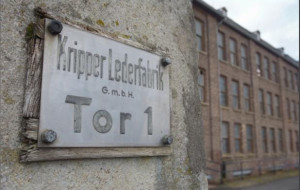 My cousin Barbara and I visited the area in the 20th Century, and evidently time has not altered it so very much, still the same cobbled streets and factory ‘Lederfabrik’ stil there. My Aunt Clare was able to recognise many features from the photographs.
My cousin Barbara and I visited the area in the 20th Century, and evidently time has not altered it so very much, still the same cobbled streets and factory ‘Lederfabrik’ stil there. My Aunt Clare was able to recognise many features from the photographs.
The family would have arrived back in England about 1910. They lived at 46 Senegal Road, Bermondsey. Joe went over to America to see how the tanneries were there but he did not like the conditions. He was later offered a job by Broadhurst Tanneries and so he came to Australia with his eldest son, Joseph Henry.
He acquired a house at 36 Regent Street, Regent, with one acre of land and an eight room house and a large shed – it was nearly opposite the Regent Railway Station. Broadhurst had paid the fares to Australia for Joseph and his son, and Joseph worked for them and managed their patent leather and graining sections, and was a Finisher. The Electoral Roll had the family at Regent Street in 1912 and 1914.
His family had come to Australia to join him on the Demonsthenes and arrived on October 5, 1911. Whilst his father was away and on the boat Bert had to look after the family. They brought with them Mary (Bess) Cannon, age 22, who was coming to Australia to marry Joseph’s eldest son, Joseph Henry.
In 1915, we find the family were living at 81 Gooch Street, Thornbury. This is the area to which my mother, Honora O’Brien, came. She had known my father Albert (Bert) Fletcher Lawrence in England, and it was from this Gooch Street home that they married on January 30, 1915.
In 1916, Joseph was a Director of the ‘Lawrence Norton’ factory/ They dyed kit bags (khaki haversacks) for World War I. Later this firm is called ‘Lawrence and Russell’, and was in Coppin Street, Burnley.
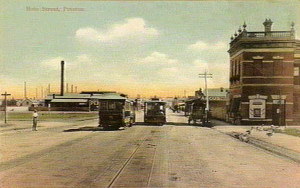
Cable trams in High St, Thornbury, in 1909, looking south. The Lawrence Leathers factory was to be established on land to the left of the photo.
In 1917 he shifted to 12 Clarendon St, Thornbury. Here he had a four-bedroom house with plenty of land around it and large outhouses and small factories behind it. A furniture factory was also behind the house. Joe was now 48 years of age. His two eldest sons were married. Joseph Henry had his own factory and had four children. Bert lived in the same Clarendon Street, at number 37, and had one child. Ida was 24; most likely she was married to Reginald Geach. George is 21 and was overseas with the Army. Frank is age 19. Clara is 17 and at home, helping her mother. Arthur is 14, and Robert (Bob) was 12.
Clara had been at Northcote (Helen Street) Primary School so I presume Arthur and Bob went there to. Later the boys were to attend Collingwood Technical School.
Joe must have decided to have his own leather business. I can remember my father Bert saying: “The factory was started with a few bob and a couple of drums.” (‘Bob’ was the slang word for a shilling, and ‘drums’ were a type of barrel.) They most likely began in an old two-storey factory that was at the back of Joe’s garde. Around 1922, this factory caught fire and was burnt down.
The story of Lawrence Leathers is told separately. As the family grew so did the business of Lawrence Leathers. Joe used to a lot of the buying and he used to visit the Wool Exchange Hotel in the City where he would play Crib and do the buying. He most likely knew a lot of the tanners of Melbourne, as many of them had come from England. He became a Master Tanner and their main product was making the leather and doing the linings for the inside of men’s felt hats. The skins mostly used were sheep-skins. As most men in those days wore a hat, it was a thriving business.
He liked the good life and was very keen on horse racing. He had a strong personality. His family were very lively and go-ahead people. He had a very comfortable home. One year, he and all the men of the family and some friends went to Sydney and back, from Melbourne, by their cars. Quite a feat in those days of the 1920s.
In 1926, he started to work only two to three hours a day, generally with a group of his employees, as he liked to oversee a job. Once he was was semi-retired he proceeded to enjoy himself, belonging to his clubs, going to the races, drinking, and treating himself to luxuries. He liked to dress well; he always wore a hat and smoked cigars.
There is a story that one day he could not get a taxi to come home from the races, so he hired a char-a-banc (a long length car with many bench seats) and he arrived home, sitting in style. Later on, about 1931, he bought himself a Silver Anniversary Buick from Bob Broadhurst. He did not drive it himself, but let one of the employees of the factory, Jim Harvey, drive him about.
His family lived around him in Thornbury. Bert was now at 18 Clarendon Street. Arthur, who married Norma Grant, lived about three streets away in Rossmoyne Street. Frank married May Johnson, and lived in St George’s rd, Preston, about a kilometre or so away. Clara married Cliff Forrester, and lived in a three room flat attached to Joe’s home. George was at home – but he was not a well man as he suffered from ill effects of the War years. Eldest son Joseph Henry was living at Black Rock. Idea was probably living on a farm at Neerim or minding a home in Brighton. Bob was also at home – he was later in 1934 to marry Ethel Booth who lived at No 25 Clarendon Street, and they were to live at No 19 Clarendon Street.
Joe was always interested in markets. At one time he had drawn up a plan with the local publican, Ma Kelly from the Croxton Hotel, and some other local people. This was a plan to build a market in Northcote, but this did not happen.
In 1927 he took his wife Sarah on a trip to England on the RMS Osterley (Orient). Whilst there, they evidently met up with all their families, and a George Forrest in England can remember them at the races at Brighton. They also went up to Cockermouth to meet up with Sarah’s family, who were Fletchers with tanneries. When they came home they bought my mother’s sister, Julia O’Brien, with them. I can remember, as a little girl, how excited we were they came home laden with presents for everyone. My grandmother also gave me a crystal perfume bottle which she said came from France. I do not know if they visited there or maybe it came from Grandma’s time before she was married, when she worked for a French confectioner.
They bought themselves a beach house – a large weatherboard house with a turret on top in Seaview Crescent, Black Rock. Joseph Henry and his family were already living in Black Rock. In later years Ida and then also Clara were to live in that suburb, and Frank took over the house in Seaview Crescent, and reared his family there.
My grandmother Sarah died on April 26 at 12 Clarendon St. She was then 72 years of age.
Joseph, at that time, was still very healthy and well. About 1940 he re-married, to a young woman, a Jean Williamson, born 1915. She had been employed by the local greengrocer, and Joe became friendly with her. He was 71 years and she was 25 years. She looked after him well. As a young married woman, I lived in the flat attached to their house. As he got older he spent most of his time in bed but I can remember when he wanted any attention he would stamp his walking stick on the floor, and I could hear her running up the passageway of his house, backwards and forwards, to his demands.
When he felt well he would dressed up in all his glory, hire a taxi, and go off to the club or the races. When he came home he would get back into bed. I remember one of his favourite meals was prawns and beer.
He and Jean adopted a baby girl, Beverley Joyce, in 1943 (?). The little girl gave them both a lot of pleasure.
Later, possibly about 1950, they shifted to 19 Yarraford Avenue, Alphington. He only lived there a couple of years, and he died on July 15, 1954, aged 85 years. He is buried in the Preston Cemetery.
• Joy Wood commented: In writing this story I hope I have not given my Grandfather too much of an ‘autocratic’ personality. He was a good man and raised his family to be an intelligent and happy one. In my youthful days, as the family lived close together, it seemed that they were mostly a lot of people who laughed a lot together. One of my father’s philosophies was “a cheerful grin will get you in”. Grandparents of that generation were looked upon as the ‘head’ characters in the play of life – grandparents these days are looked on as friends and playmates. To soften his personality a little, I remember him nursing and singing to various grandchildren. I also remember how at one time in their family room he picked my little grandmother up and swung her around in the air, whilst they danced and laughed together.
